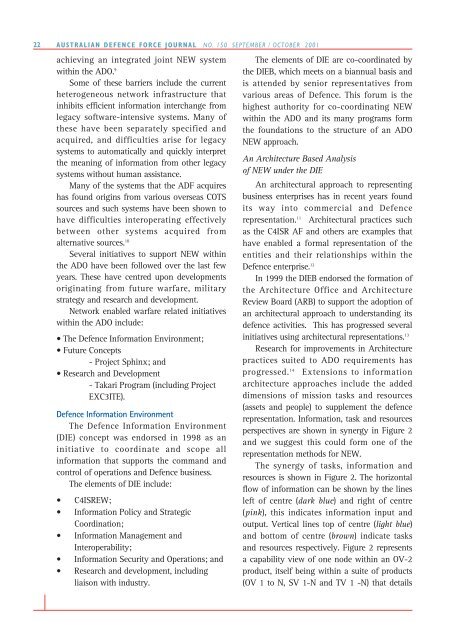ISSUE 150 : Sep/Oct - 2001 - Australian Defence Force Journal
ISSUE 150 : Sep/Oct - 2001 - Australian Defence Force Journal
ISSUE 150 : Sep/Oct - 2001 - Australian Defence Force Journal
You also want an ePaper? Increase the reach of your titles
YUMPU automatically turns print PDFs into web optimized ePapers that Google loves.
22AUSTRALIAN DEFENCE FORCE JOURNAL NO. <strong>150</strong> SEPTEMBER / OCTOBER <strong>2001</strong>achieving an integrated joint NEW systemwithin the ADO. 9Some of these barriers include the currentheterogeneous network infrastructure thatinhibits efficient information interchange fromlegacy software-intensive systems. Many ofthese have been separately specified andacquired, and difficulties arise for legacysystems to automatically and quickly interpretthe meaning of information from other legacysystems without human assistance.Many of the systems that the ADF acquireshas found origins from various overseas COTSsources and such systems have been shown tohave difficulties interoperating effectivelybetween other systems acquired fromalternative sources. 10Several initiatives to support NEW withinthe ADO have been followed over the last fewyears. These have centred upon developmentsoriginating from future warfare, militarystrategy and research and development.Network enabled warfare related initiativeswithin the ADO include:• The <strong>Defence</strong> Information Environment;• Future Concepts- Project Sphinx; and• Research and Development- Takari Program (including ProjectEXC3ITE).<strong>Defence</strong> Information EnvironmentThe <strong>Defence</strong> Information Environment(DIE) concept was endorsed in 1998 as aninitiative to coordinate and scope allinformation that supports the command andcontrol of operations and <strong>Defence</strong> business.The elements of DIE include:• C4ISREW;• Information Policy and StrategicCoordination;• Information Management andInteroperability;• Information Security and Operations; and• Research and development, includingliaison with industry.The elements of DIE are co-coordinated bythe DIEB, which meets on a biannual basis andis attended by senior representatives fromvarious areas of <strong>Defence</strong>. This forum is thehighest authority for co-coordinating NEWwithin the ADO and its many programs formthe foundations to the structure of an ADONEW approach.An Architecture Based Analysisof NEW under the DIEAn architectural approach to representingbusiness enterprises has in recent years foundits way into commercial and <strong>Defence</strong>representation. 11 Architectural practices suchas the C4ISR AF and others are examples thathave enabled a formal representation of theentities and their relationships within the<strong>Defence</strong> enterprise. 12In 1999 the DIEB endorsed the formation ofthe Architecture Office and ArchitectureReview Board (ARB) to support the adoption ofan architectural approach to understanding itsdefence activities. This has progressed severalinitiatives using architectural representations. 13Research for improvements in Architecturepractices suited to ADO requirements hasprogressed. 14 Extensions to informationarchitecture approaches include the addeddimensions of mission tasks and resources(assets and people) to supplement the defencerepresentation. Information, task and resourcesperspectives are shown in synergy in Figure 2and we suggest this could form one of therepresentation methods for NEW.The synergy of tasks, information andresources is shown in Figure 2. The horizontalflow of information can be shown by the linesleft of centre (dark blue) and right of centre(pink), this indicates information input andoutput. Vertical lines top of centre (light blue)and bottom of centre (brown) indicate tasksand resources respectively. Figure 2 representsa capability view of one node within an OV-2product, itself being within a suite of products(OV 1 to N, SV 1-N and TV 1 -N) that details
















